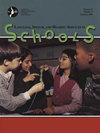儿童早期父母报告的言语和语言是澳大利亚土著儿童读写和计算结果的早期指标。
IF 2.9
3区 医学
Q1 AUDIOLOGY & SPEECH-LANGUAGE PATHOLOGY
Language Speech and Hearing Services in Schools
Pub Date : 2025-05-19
DOI:10.1044/2025_lshss-23-00200
引用次数: 0
摘要
目的本研究的目的是纵向调查父母报告的儿童早期言语和语言作为澳大利亚原住民学龄教育成果的早期指标。方法研究对象为1534名来自土著儿童纵向研究(LSIC)的儿童,这些儿童的父母在3-5岁时使用父母发展状况评估报告表达性和接受性言语和语言关注(SLC)。共467例(30.4%)被确定为SLC,其中308例为表达性SLC, 65例为接受性SLC, 81例为表达性和接受性SLC。教育成果包括(a)国家评估方案-识字和计算能力(NAPLAN)测试(3年级,8-9年级),(b)教师根据学术评定量表报告的识字和计算能力(ARS);8-9岁,9-10岁),以及(c)研究人员管理的阅读进步成就测试(PAT-Reading);6-7岁、7-8岁、8-9岁、9-10岁)和进阶数学成就测试(PAT-Maths;8-9岁,9-10岁)。结果在控制了相关变量(儿童年龄、性别、是否有听力问题、是否有残疾、是否使用土著语言、父母教育程度、家庭生活事件、社区社会经济地位和偏远程度)后,SLC与所有NAPLAN子测试(阅读、写作、拼写、语法、算术)、教师评定的语言和读写能力ARS(9-10岁)、pat -阅读(6-7岁)和pat -数学(9-10岁)的分数显著降低相关。亚组比较表明,表达性和接受性SLC患儿的NAPLAN和ARS亚测试结果最差。结论澳大利亚土著儿童早期SLC的父母报告是学校教育成果的重要早期指标,表明家庭在儿童学习和发展轨迹中的重要性。本文章由计算机程序翻译,如有差异,请以英文原文为准。
Parent-Reported Speech and Language in Early Childhood Is an Early Indicator of Indigenous Australian Children's Literacy and Numeracy Outcomes.
PURPOSE
The aim of this study was to longitudinally investigate parent-reported children's speech and language in early childhood as an early indicator of Indigenous Australians' school-age educational outcomes.
METHOD
Participants were 1,534 children from the Longitudinal Study of Indigenous Children (LSIC) whose parents reported on expressive and receptive speech and language concern (SLC) at 3-5 years using the Parents' Evaluation of Developmental Status. A total of 467 children (30.4%) were identified as having SLC, of whom 308 had only expressive SLC, 65 had only receptive SLC, and 81 had both expressive and receptive SLC. Educational outcomes included (a) National Assessment Program-Literacy and Numeracy (NAPLAN) tests (Grade 3, 8-9 years), (b) teacher-reported literacy and numeracy on the Academic Rating Scale (ARS; 8-9, 9-10 years), and (c) research officer-administered Progressive Achievement Tests in Reading (PAT-Reading; 6-7, 7-8, 8-9, 9-10 years) and Progressive Achievement Tests in Mathematics (PAT-Maths; 8-9, 9-10 years).
RESULTS
After controlling for covariates (child age, sex, having hearing problems, having a disability, speaking an Indigenous language, parent education, family life events, community socioeconomic status, and remoteness), SLC was associated with significantly lower scores on all NAPLAN subtests (Reading, Writing, Spelling, Grammar, Numeracy), teacher-rated ARS for Language and Literacy (9-10 years), and PAT-Reading (6-7 years) and PAT-Maths (9-10 years). Subgroup comparisons indicated that children with both expressive and receptive SLC had the poorest outcomes on NAPLAN and ARS subtests.
CONCLUSION
Parental reporting of Indigenous Australian children's SLC in early childhood is an important early indicator of education outcomes at school, indicating the importance of families throughout a child's trajectory of learning and development.
求助全文
通过发布文献求助,成功后即可免费获取论文全文。
去求助
来源期刊

Language Speech and Hearing Services in Schools
Social Sciences-Linguistics and Language
CiteScore
4.40
自引率
12.50%
发文量
165
期刊介绍:
Mission: LSHSS publishes peer-reviewed research and other scholarly articles pertaining to the practice of audiology and speech-language pathology in the schools, focusing on children and adolescents. The journal is an international outlet for clinical research and is designed to promote development and analysis of approaches concerning the delivery of services to the school-aged population. LSHSS seeks to advance evidence-based practice by disseminating the results of new studies as well as providing a forum for critical reviews and meta-analyses of previously published work.
Scope: The broad field of audiology and speech-language pathology as practiced in schools, including aural rehabilitation; augmentative and alternative communication; childhood apraxia of speech; classroom acoustics; cognitive impairment; craniofacial disorders; fluency disorders; hearing-assistive technology; language disorders; literacy disorders including reading, writing, and spelling; motor speech disorders; speech sound disorders; swallowing, dysphagia, and feeding disorders; voice disorders.
 求助内容:
求助内容: 应助结果提醒方式:
应助结果提醒方式:


